De bästa apparna för tidsregistrering för designers
Oavsett om du är en frilansande kreativ konstnär, en designteammedlem eller en byråpersonal är effektiv tidshantering avgörande för din framgång och kundnöjdhet. Tidsspårning är en viktig vana som hjälper designers att uppskatta längden på sina uppgifter och fakturera kunderna korrekt. Låt oss dyka djupt in i de bästa apparna för tidsspårning för designers!
Den bästa lösningen för tidrapportering för att öka en designers produktivitet och säkerställa korrekt fakturering och tidsuppskattningar.
Vilka är de bästa apparna för tidsregistrering för designers?
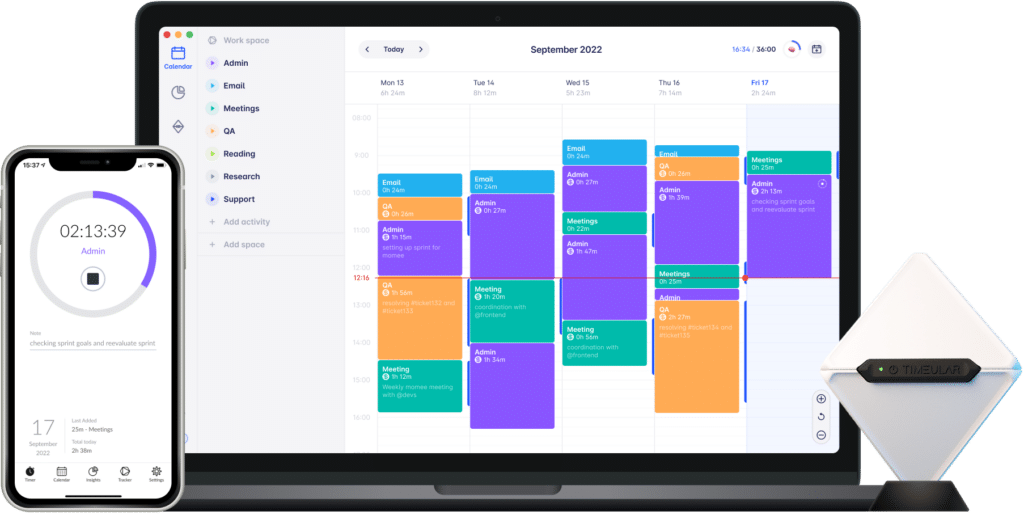
1. Timeular
Timeular sticker ut som det bästa tidsregistreringsverktyget för designers eftersom det är enkelt att använda, intuitivt och automatiserar de flesta av de besvärliga tidsregistreringsuppgifterna som teammedlemmar annars borde göra manuellt. Du kan använda den för Mac-tidsspårning och Windows-tidsspårning.
I synnerhet uppskattar konstruktörerna följande egenskaper hos Timeular:
- Flera alternativ för tidsrapportering
- Automatiserade rapporter
- Intuitiv och flexibel spårning av fakturor
- Budgetar
- Spårning av ledighet
Timeular programvaran för tidsregistrering har sparat oss så mycket tid. Det har redan betalat för sig eftersom vi sparar minst två timmar varje månad genom att inte längre överföra uppgifter som skrivits ner på papper till vårt gamla system
Ingólfur Magnússon, flygprocedurdesigner på Isavia ANS
Timeular gör tidrapporteringen enkel och rolig
I Timeular kan du följa tiden med flera olika metoder och hitta den som passar dig bäst:
- Att vända på den fysiska tidsregistreringskuben - och hårdvara som du kan vända på för att börja registrera upp till 1.000 aktiviteter
- Aktivera automatiserad tids registrering - gör din uppgift och Timeular registrerar ditt arbete i bakgrunden. Den kan också föreslå tidsposter baserat på din kalender och tidigare poster eftersom det är en AI-driven tidsregistreringsapp.
- Använda kortkommandon på tangentbordet
Timeular är allmänt känd för sin fysiska Tracker som ansluts till appen via Bluetooth. Eftersom du enkelt kan anpassa den genom färgglada klistermärken och pennor fungerar den 8-sidiga matrisen som en fysisk påminnelse som ligger på ditt skrivbord.
Observera: Du behöver inte Tracker för att använda Timeular programvara.
Hur fungerar den? Tilldela dina aktiviteter till varje sida av Tracker och slå tärningen för att starta en ny tidspost. Om det behövs kan du redigera posten i appen efteråt genom att lägga till taggar och anteckningar. Det är så enkelt som det är!
- Kul fakta: Visste du att Timeular är ett av de bästa AI-verktygen för designers?
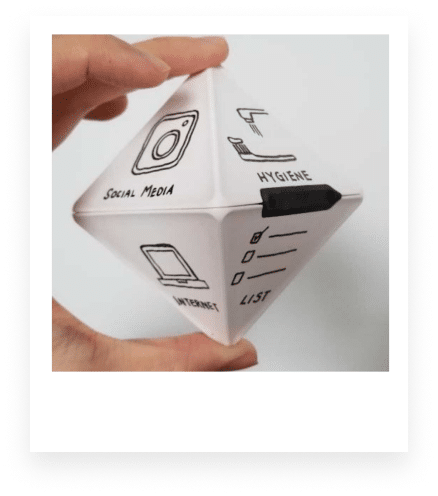
Skapa en vana med hjälp av muskelminne och en kraftfull fysisk påminnelse. Alla nya användare får 2 månaders gratis prenumeration när de ansluter en ny Tracker.
Smidig användarupplevelse och enkla metoder för tidsregistrering gör Timeular till förstahandsvalet för designers som vill registrera sin tid exakt på mindre än 1 minut per dag.
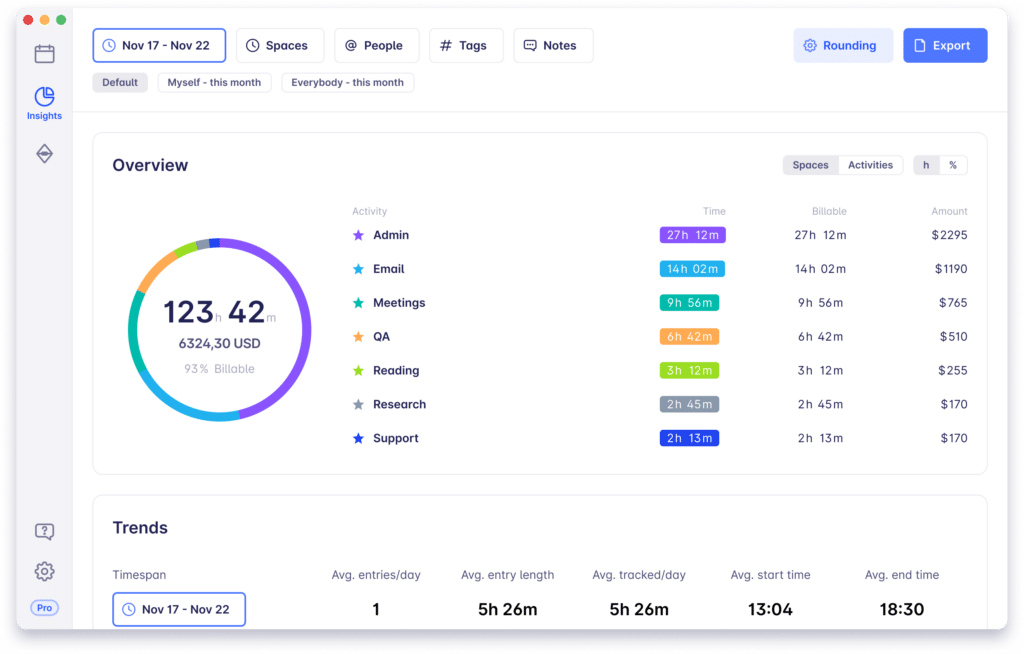
Automatiserade rapporter
Timeular automatiserar spårning av fakturerbara timmar och skapar tydliga och transparenta tidrapporter för dina kunder. Appen ger en exakt uppdelning av dina aktiviteter för att säkerställa att varje liten uppgift spåras och läggs till på din faktura. Du kan exportera dina rapporter till PDF, XLSX eller CSV.
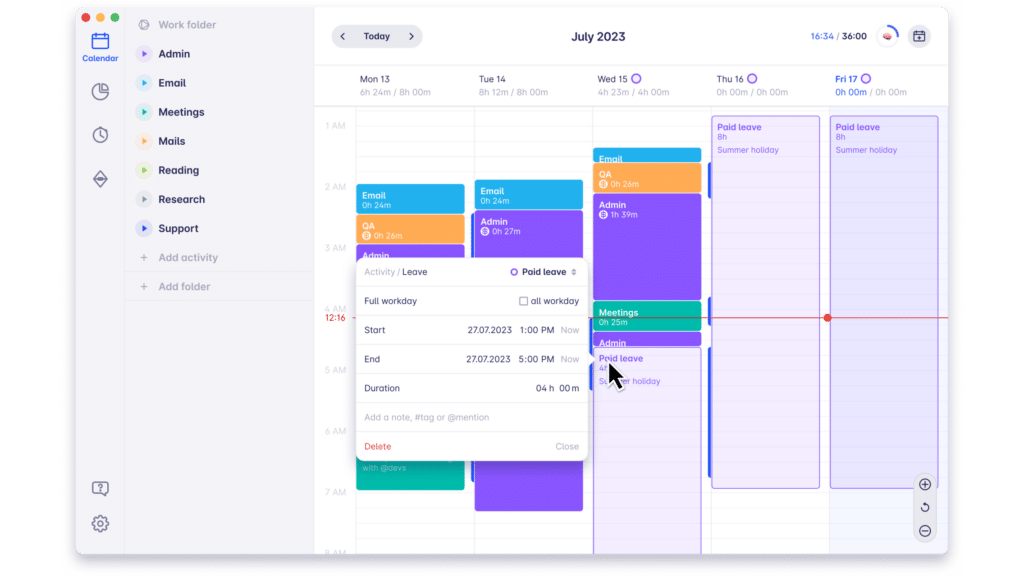
Registrera arbetstid, övertid och alla typer av ledigheter
Utnyttja Timeular för spårning av arbetstid, ledighet och övertid, så att du kan ta ansvar för ditt arbetsschema. Det ger en sömlös metod för att lägga till och övervaka alla ledighetsförfrågningar i ditt team, vilket förbättrar flexibiliteten och transparensen i ledighetsspårning och rapportering.
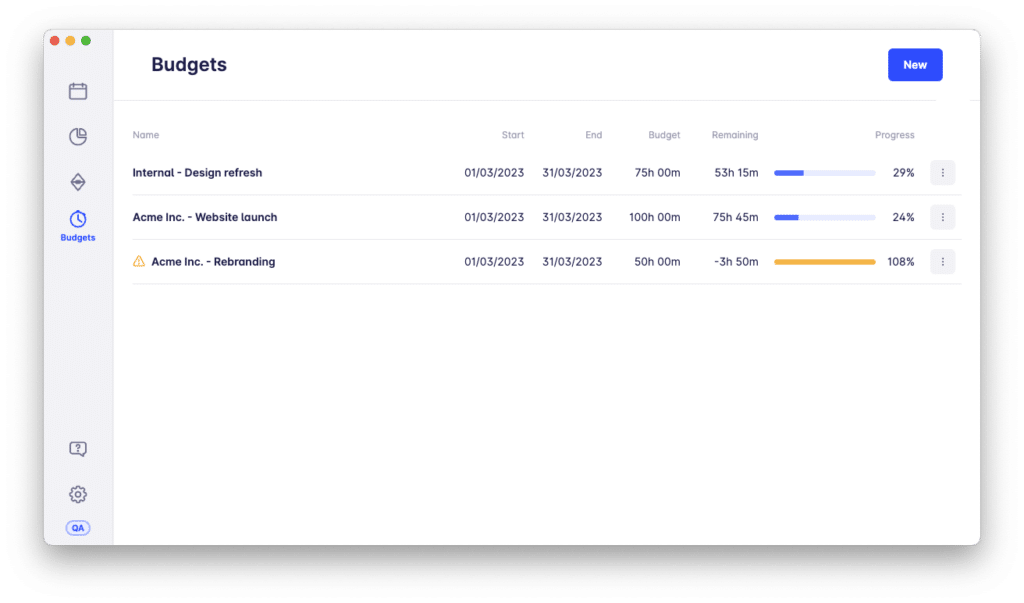
Det håller budgetarna under kontroll
I Timeular kan du noggrant övervaka projektbudgetar för att effektivt följa upp deras framsteg och lönsamhet. Du kan snabbt identifiera projekt som riskerar att överskrida budgeten och omfördela designteamets tid till de områden där den behövs mest.
Priserna börjar på 6,30 € per månad.
Med Timeular kan designers:
- Skapa en vana att spåra tid: Designers kan enkelt följa sin tid med hjälp av genvägar eller tidsregistreringsenheten, vilket hjälper till att förstärka vanan med tidsregistrering. Timeular är också ett program för automatisk tidsregistrering, vilket hjälper team att samla in ännu mer exakta data.
- Öka transparensen och samarbetet: Du registrerar tid och anpassar tidsposterna med anteckningar och taggar, som kan delas med ett team. Designers kan spåra tid tillsammans med hjälp av delade mappar och skapa individuella och teamrapporter för bättre tidshantering och resursallokering.
- Öka fakturerbara timmar: Timeular är den mest exakta programvaran för att spåra fakturerbara timmar eftersom fakturerbara timmar kan spåras helt enkelt genom att växla en växling.
- Förbättra tidsuppskattningar och kundnöjdhet: Eftersom Timeular är så enkelt att använda blir tidsuppgifterna mer exakta. För konstruktörerna blir det lättare att göra korrekta tidsuppskattningar och uppfylla intressenternas och kundernas förväntningar.
- Spåra tid med hela teamet: Tack vare avancerade funktioner för tidsrapportering för team är det enkelt och smidigt att registrera tid med kollegor.
Betyg
Bästa egenskaper
- Fysisk spårare
- Quicktrack, som gör det möjligt att starta nya tidsposter med kortkommandon
- Enkel tidsregistrering var du än befinner dig tack vare en mobilapp
- Automatiserad tidrapportering
- Automatiserad datavisualisering och insikter
- Korrekt fakturering med anpassade rapporter och dataexport
- Lägga till anteckningar och taggar till tidsposter
- Spårning av ledighet
- Delade mappar för att hålla koll på tiden med ditt team
- Automatiserade, korrekta och snygga rapporter till kunderna
- Uppföljning av projekttimmar
- Över 3.000 appar integrerade via Zapier
Den mest exakta och enkla tidsregistreringen för designers.
2. Toggl spår
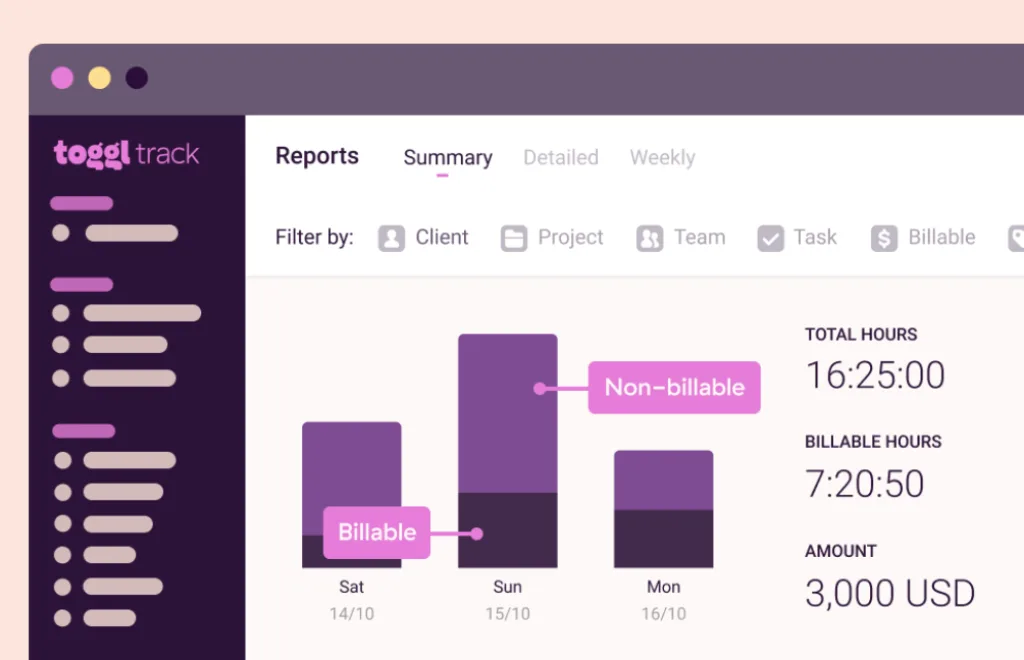
Toggl är ett populärt tidrapporteringsverktyg som erbjuder ett brett utbud av funktioner; tidsspårning kan göras antingen automatiskt eller manuellt. Toggl är ett rimligt val för dem som letar efter ett gratis verktyg med en strömlinjeformad tidtabellsupplevelse, offline-spårning och projektuppskattningar. Tyvärr har Toggl en prenumeration för betalning per plats som gör det dyrare än andra lösningar för tidsspårning.
Fördelar med Toggl
- Det är ett billigare alternativ
- Det erbjuder en freemium-version
- Rapportering av detaljer
- Automatiserad tidrapportering
Nackdelar med Toggl
- Den kostnadsfria versionen har minimala funktioner.
- Det är en brant inlärningskurva
- Ingen spårning av ledighet
- Har inga AI-integrerade lösningar
Läs också: Timeular vs Toggl
3. Skörd
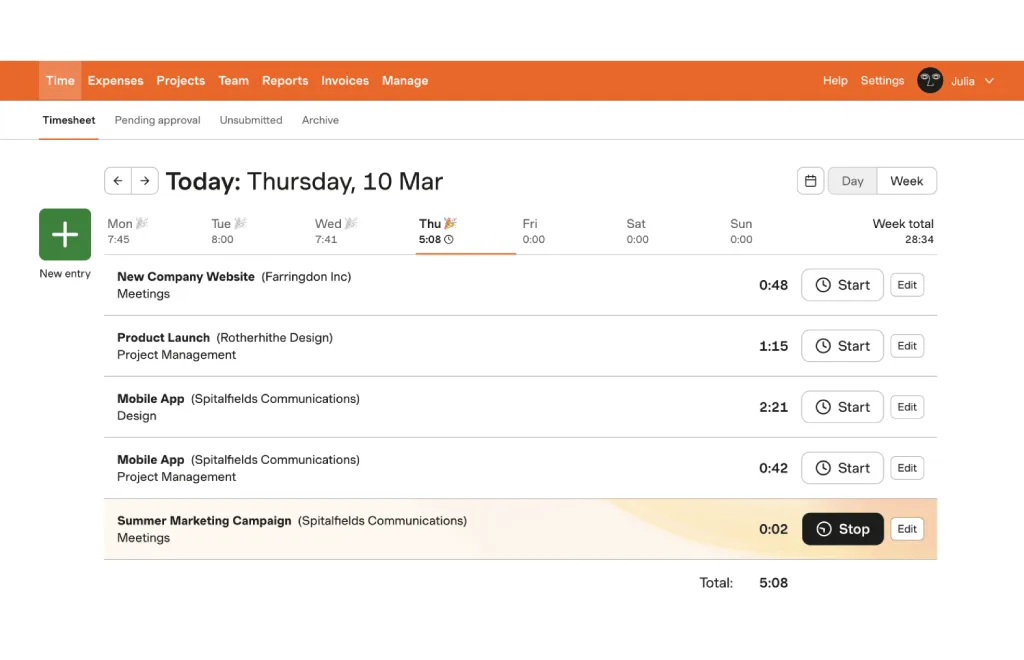
Harvest hjälper designers att hålla koll på sin tid och gör det möjligt för team att enkelt generera fakturor. Trots det förlitar sig ti fortfarande mycket på manuell tidrapportering, vilket kan vara besvärligt och slöseri med tid.
Fördelar med skörd
- Billigare än i rätt tid
- Generera fakturor
- Effektiviserar betalningar
- Erbjuda schemaläggning av ledig tid
Nackdelar med skörd
- Manuell tidsregistrering
- Ingen spårning av ledighet
- Den kostnadsfria planen är starkt begränsad
- Det finns ingen automatisk tidrapportering
- Inlärningskurvan är ganska brant
Läs också:
4. Klockifiera
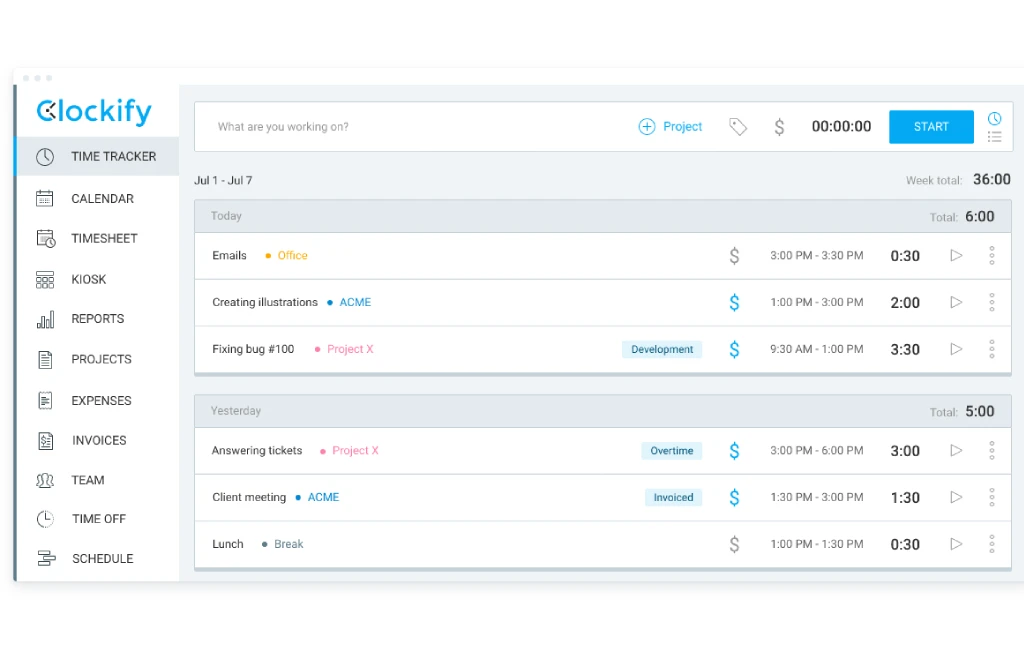
Clockify är ett teamhanteringsverktyg för tidrapportering, fakturering och schemaläggning. Clockify tillåter automatisk tidsspårning.
Trots att verktyget gör sig bäst när det används i team har Clockify fått kritik för att inte respektera de anställdas integritet. Mjukvarans hantering av användardata har väckt oro bland användare och integritetsförespråkare, vilket har gjort den till ett kontroversiellt ämne.
Fördelar med Clockify
- Tillåter spårning av ledig tid
- Har automatisk spårning
- Godkännande av tidrapporter
Nackdelar med Clockify
- Intrång i anställdas privatliv
- Har begränsade integrationer
- Klumpig mobilapp
- Begränsade rapporteringsfunktioner
Relaterat också:
5. Tidsdoktorn
Time Doctor har blivit populärt som tidsspårare och arbetsbevis, men det kanske inte passar alla team. När Time Doctor används är användarna oroliga för sin integritet och beklagar sig över föråldrade funktioner, begränsad funktionalitet och kundtjänst som inte svarar.
Fördelar med Time Doctor
- Exakt tidsrapportering
- Produktivitetsinsikter
- Integration och kompatibilitet
Nackdelar med Time Doctor
- Oro för den personliga integriteten
- Inlärningskurva
- Ingen spårning av ledighet
- Begränsade mobila funktioner
- Kostnad
- Övervakning av anställda
TIPS: Lär känna listan över de bästa alternativen till Time Doctor
6. Tick
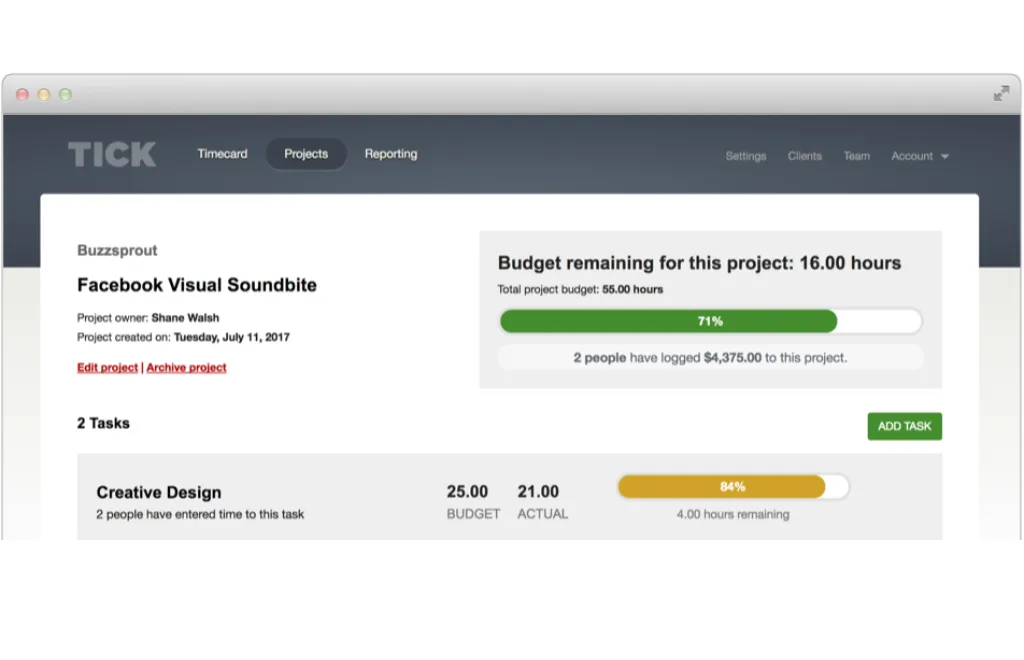
En pålitlig programvara för tidsspårning för småföretag. Det erbjuder en förenklad plattform för tidshantering och projektspårning, som kännetecknas av enkelhet. Det spårar tid utan att störa det kreativa arbetsflödet.
Även om Tick anses vara ett bra verktyg har det föråldrade och underutvecklade gränssnittet bidragit till att det har fått låga betyg, 2 stjärnor, i Google Play Store.
Budgeteringsfunktionen gör det möjligt för designers att övervaka projektkostnader och se till att de håller sig inom budgetbegränsningarna. Tick har en kostnadsfri plan som endast omfattar ett projekt.
Fördelar med Tick
- Enkelt och intuitivt gränssnitt
- Anpassningsbara projekt och uppgifter
- Budgetuppföljning
- Alternativ för integration
Nackdelar med Tick
- Begränsade funktioner
- Ingen automatisk tidsregistrering
- Begränsad mobil funktionalitet
- Struktur för prissättning
7. Hubstaff
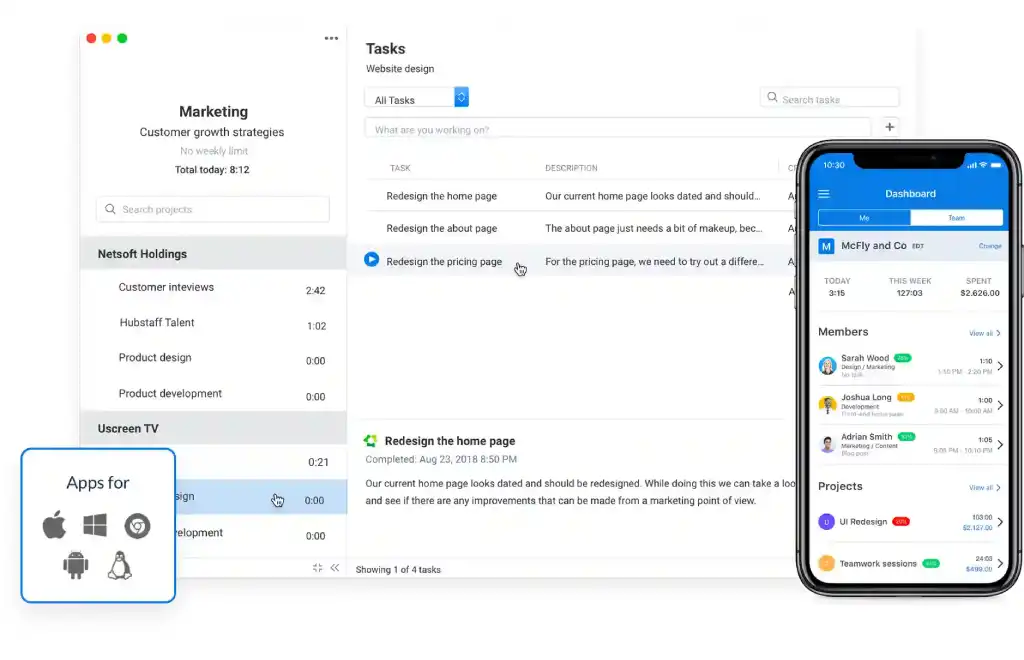
Vi vet att Hubstaff är erkänt som en betydande aktör i produktivitets- och tidsregistreringsprogramvaran, men en av dess nackdelar är att människor klagar över att det används för mikromanagement och intrång i anställdas integritet.
Hubstaff erbjuder tidsspårningsfunktioner som gör det möjligt för anställda att logga sina timmar för olika uppgifter och projekt. Det inkluderar också GPS-spårning och aktivitetsövervakning, samt schemaläggning av anställda, projektledning och löneintegrationer.
De övervakningsmöjligheter som Hubstaff erbjuder väcker olika känslor hos användarna: vissa hatar det och andra tolererar det. Många användare uppger att programvarans inlärningskurva kan vara för komplex och tidskrävande, särskilt för dem som främst behöver grundläggande funktioner för tidsspårning.
Fördelar med Hubstaff
- korrekt tidsregistrering
- insikter om produktivitet
- integrationsmöjligheter
- löner och fakturering
Nackdelar med Hubstaff
- integritetsfrågor
- inlärningskurva
- resurskrävande
- kostnad
Läs också: Alternativ till Hubstaff
8. I rätt tid
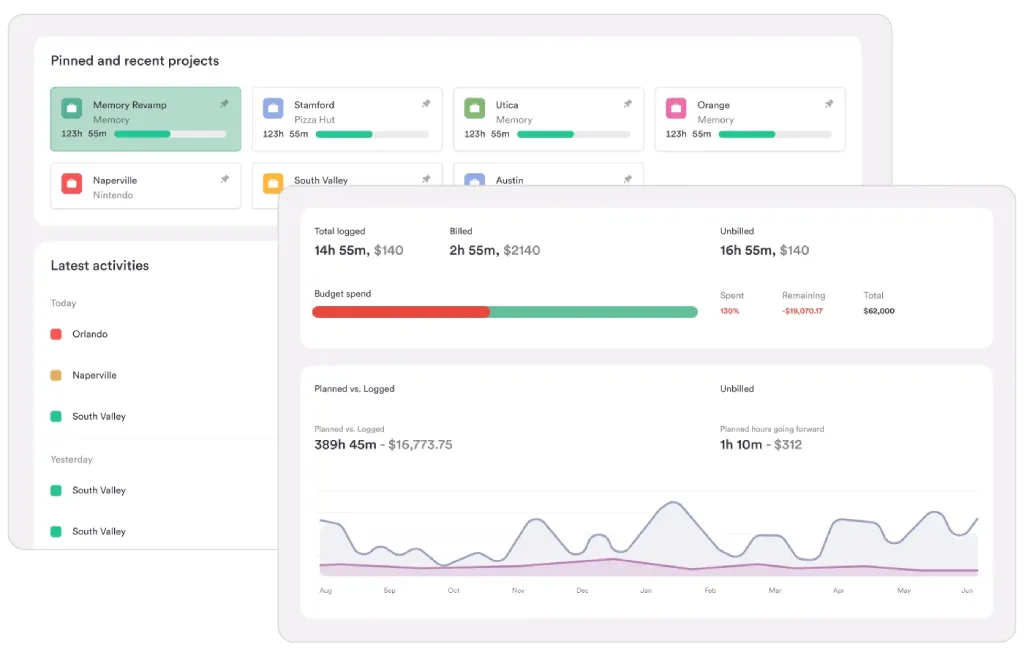
Timely är en helautomatisk lösning för tidrapportering. Denna programvara syftar till att effektivisera tidshanteringen för individer och team. Den utnyttjar artificiell intelligens för att automatiskt fånga och kategorisera användarnas tid som spenderas på olika uppgifter och projekt.
Online-granskare berömmer Timelys AI-tidsspårningsfunktioner, vilket sparar tid och ansträngning. Men vissa granskare har också uttryckt en önskan om ytterligare integrationer med ett bredare utbud av produktivitetsverktyg för att förbättra Timelys funktionalitet.
Prissättning är en annan aspekt som ibland genererar blandade känslor, med vissa användare som föreslår mer flexibla planer eller konkurrenskraftiga prisalternativ.
Fördelar med lägligt
- intuitivt gränssnitt
- automatisk tidrapportering
- detaljerade rapporter och insikter
- integration av projekt- och uppgiftshantering
Nackdelar med lägligt
- begränsad offline-funktionalitet
- inlärningskurva för avancerade funktioner
- potentiellt hög kostnad
- kanske inte passar alla branscher eller användningsområden
Läs också om detta: Alternativ i rätt tid
9. RescueTime
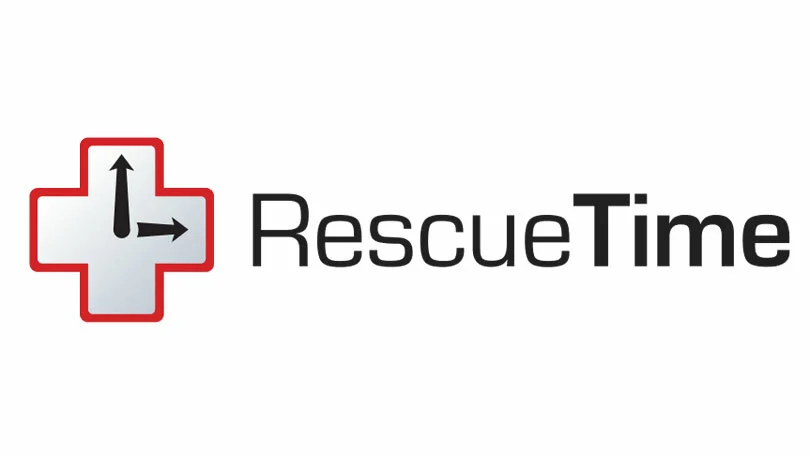
RescueTime är en fullt utvecklad automatiserad tidsregistreringslösning och konkurrerar väl med Timely. RescueTime är dock främst inriktat på personlig produktivitet och inte på projektspårning.
Fördelar med RescueTime
- Hjälper användarna att förbättra fokus och produktivitet
- Har smarta coachningsvarningar
- Automatiserad spårning
- Spårning offline
Nackdelar med RescueTime
- Den lämpar sig inte för team eller projekt
- Det stöder inte spårning av fakturerbara timmar
- Buggig app
TIPS: Läs vårt inlägg om du letar efter ett alternativ till RescueTime
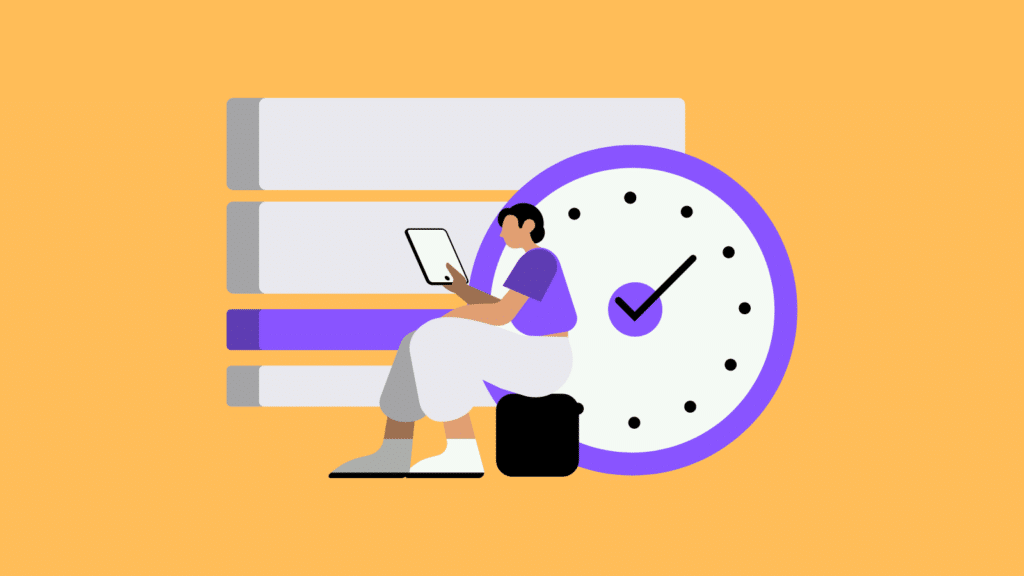
Fördelarna med programvara för tidsregistrering för designers
Att använda en app för tidsregistrering för designers ger många fördelar, till exempel att förbättra tidsuppskattningar, spara tid och stärka kundernas förtroende. Här är de viktigaste fördelarna eller fördelarna:
- Korrekt fakturering - appar för tidsspårning gör det möjligt för designers att exakt spåra den tid som spenderas på varje projekt eller uppgift. Detta säkerställer att kunderna faktureras korrekt, vilket minskar tvister om fakturor och ökar de totala intäkterna. Programvara för tidsspårning integreras ofta med faktureringsverktyg, vilket gör det enkelt att generera korrekta fakturor. Detta effektiviserar faktureringsprocessen och säkerställer att designers kompenseras snabbt.
- Förbättrad produktivitet - när designers registrerar sin tid blir de mer medvetna om hur de använder sin arbetstid. Denna medvetenhet kan leda till bättre tidshantering, ökat fokus och högre produktivitet.
- Mer effektiv projekthantering - Program för tidsregistrering innehåller ofta funktioner för projekthantering. Designers kan använda dessa verktyg för att skapa och organisera uppgifter, prioritera och fördela tid till olika projekt och se till att deadlines hålls.
- Förbättrad transparens i faktureringen - att dela tidrapporteringsdata med kunderna kan skapa förtroende och transparens.
- Rättsligt skydd - tidrapporteringen kan fungera som rättsligt skydd vid tvister eller oenigheter med kunder. Det ger bevis på utfört arbete och nedlagd tid.
- Tillgång till datadrivna insikter - tidsspårning genererar värdefulla data som designers kan använda för att analysera sina arbetsmönster. Genom att identifiera vilka uppgifter som tar upp mest tid kan designers fatta välgrundade beslut om hur de ska optimera sitt arbetsflöde.
Tidrapportering hjälper också designers att upprätthålla en sundare balans mellan arbete och fritid. Det gör att de kan se hur mycket tid de ägnar åt arbete och personliga aktiviteter, vilket gör det lättare att sätta gränser och prioritera egenvård.
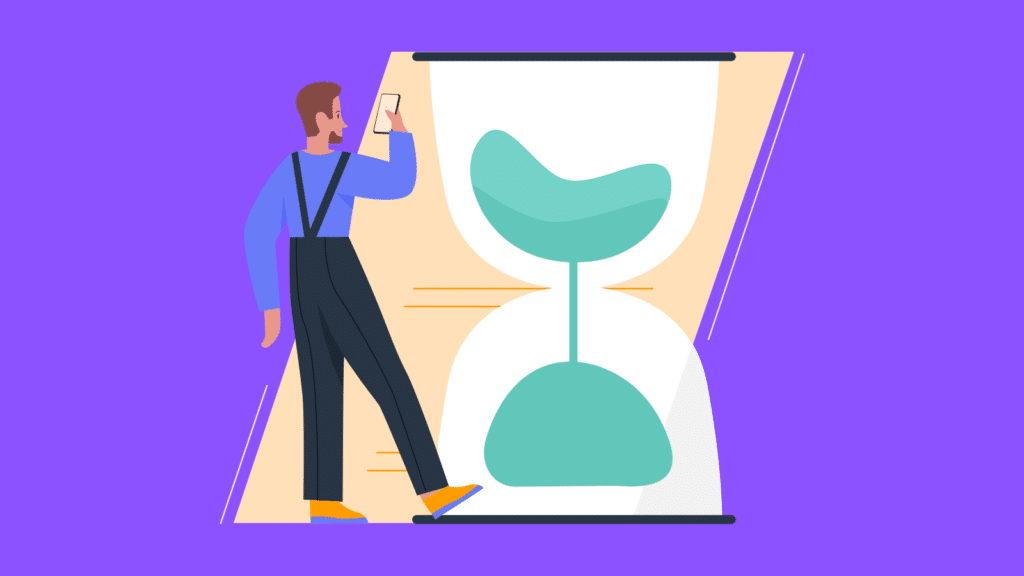
Hur väljer jag den bästa appen för tidsregistrering för designers?
Här följer några viktiga steg som hjälper dig att välja det perfekta verktyget för tidrapportering:
1. Definiera dina behov
Börja med att tydligt beskriva dina specifika behov som designer. Ta hänsyn till faktorer som vilken typ av projekt du arbetar med, storleken på ditt team (om tillämpligt) och om du behöver ytterligare funktioner som projekthantering, rapportering eller fakturering.
2. Välj ett användarvänligt verktyg
Välj ett tidsregistreringsverktyg som har ett intuitivt och användarvänligt gränssnitt. Formgivare behöver ofta ett verktyg som gör att de kan fokusera på sitt kreativa arbete i stället för att lägga onödig tid på att lära sig hur programvaran ska användas.
3. Satsa på kompatibilitet mellan plattformar
Se till att byråns programvara för tidsspårning fungerar sömlöst på olika plattformar, inklusive webb, skrivbord och mobil. Detta är särskilt viktigt om du arbetar i en byrå. Den flexibilitet som kompatibilitet ger gör att du kan spåra din tid, oavsett om du är på kontoret, på språng eller arbetar på distans.
4. Välj en programvara som tillåter anpassning
Överväg ett tidrapporteringssystem som erbjuder anpassningsalternativ.
Detta inkluderar möjligheten att skapa anpassade taggar, etiketter eller kategorier för att korrekt återspegla den typ av design eller projektarbete du utför. Detta hjälper dig att organisera ditt arbete och att se till att rapporteringen är korrekt.
5. Leta efter ett verktyg som stöder samarbete
Som designer kommer du sannolikt att arbeta med flera projekt samtidigt, och förmågan att kategorisera och spåra tid för varje projekt är avgörande.
Om du samarbetar med andra i designprojekt bör du överväga ett tidrapporteringssystem som stöder samarbetsfunktioner, t.ex. åtkomst för teammedlemmar, uppgiftstilldelning och teamkommunikation.
6. Välj ett verktyg som tillhandahåller kundsupport
Ett lyhört supportteam och rikligt med utbildningsmaterial kan vara avgörande om du stöter på problem eller har frågor om programvaran. Dra också nytta av gratis testversioner om de finns tillgängliga så att du kan testa verktyget innan du förbinder dig.
7. Fundera över dina rapporteringsbehov
Bra rapporterings- och analysfunktioner är värdefulla för designers, särskilt om de är automatiska. De ger insikter om hur du spenderar din tid, vilket kan hjälpa dig att optimera ditt arbetsflöde och identifiera områden som kan förbättras.
Slutsats
Att välja rätt app för tidsregistrering är avgörande för designers som vill optimera sitt arbetsflöde och säkerställa korrekt fakturering.
Timeular utmärker sig som den bästa tidsregistreringsappen för designers tack vare sitt användarvänliga gränssnitt, automatiska rapporter, visuella uppdelningar, exakta fakturering och funktioner för teamsamarbete.
Genom att förstå dina specifika krav kan du göra ett välgrundat val som är i linje med din kreativa process. Med den bästa appen för tidsregistrering för designers får du inte bara kontroll över din tid utan öppnar också upp för en värld av kreativ potential, vilket i slutändan ökar värdet på ditt arbete.
Tid är kreativitetens valuta, och att investera den klokt är nyckeln till din framgång som designer.
Du kanske är intresserad av: